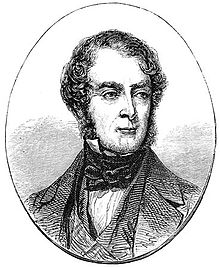George Villiers, 4th Earl of Clarendon
George William Frederick Villiers, 4th Earl of Clarendon KG GCB (born January 12, 1800 in London , † June 27, 1870 ibid) was a British nobleman , diplomat and politician.
Origin and family
George Villiers was a grandson of Thomas Villiers, 1st Earl of Clarendon , the second son of the Earl of Jersey, who in 1752 married the heiress of the last Earl of Clarendon of the Hyde family. George Villiers succeeded his uncle John Charles Villiers as Earl of Clarendon in 1838 .
In 1839 Villiers married Katherine (1810–1874), the eldest daughter of James Grimston, 1st Earl of Verulam , with whom he had the following children:
- Constance (1840–1922) ⚭ 1864 Frederick Arthur Stanley, 16th Earl of Derby
- Alice (1841–1897) ⚭ 1860 Edward Bootle-Wilbraham, 1st Earl of Lathom
- Emily Theresa (1843–1927) ⚭ 1868 Odo Russell, 1st Baron Ampthill
- Edward (1845-1846), Lord Hyde
- Edward Hyde Villiers (1846-1914), 5th Earl of Clarendon
- George Patrick (1847-1892) ⚭ 1884 Louisa Maria Maquay
- Florence Margaret (1850-1851)
- Francis (1852–1925) ⚭ 1876 Virginia Katharine Smith
Career
Villiers attended St John's College at the University of Cambridge , which he left with a degree in 1820.
He then went to the British Embassy in Saint Petersburg as an attaché for three years . Years in the customs office and at the embassy in Paris followed before Villiers was sent to Spain as ambassador in 1833 . During his time there, which was marked by the First Carlist War , he had considerable influence on the liberal government and the queen widow Maria Christina , who ruled as regent .
In 1840 he became Lord Privy Seal under Melbourne , and later also Chancellor of the Duchy of Lancaster . After the fall of the Whigs in 1841, he was an active oppositionist, but supported Peel and his brother Charles Pelham Villiers in abolishing the Corn Laws . In the government of Earl Russell he held the office of President of the Board of Trade 1846 and Lord Lieutenant of Ireland 1847-1852. The Great Famine in Ireland fell during his tenure . He turned down the positions of Governor General of India or Canada that he had been offered, because he felt that he would be too far removed from active politics.
In the government of George Hamilton-Gordon, 4th Earl of Aberdeen , a coalition between Liberals and Peelites, Villiers became foreign minister . In 1853 he was largely responsible for the involvement of Great Britain in the Crimean War . But then he helped to bring about the so-called Third Paris Peace , which ended this war. With the end of the coalition, he also left office in 1858.
It was not until 1864 that Villiers took over a public office again, namely that of Chancellor of the Duchy of Lancaster in the Palmerston government and was a participant in the London Conference in the same year . After Palmerston's death he was again Secretary of State, now again under Lord Russell. However, this government left office after a few months.
The last time Villiers held the office of foreign minister in the first Gladstone government was from 1868, without any special foreign policy activities during this period. Nevertheless he was involved in the Belgian railway crisis in 1869 .
He died in office in 1870. The earliest dignity was inherited by his eldest surviving son Edward .
literature
- The Life and Letters of George William Frederick, Fourth Earl of Clarendon V2 . Kessinger Publishing, 2007, ISBN 978-0-548-60313-0 , 2 (paperback) 1913
- HE Maxwell: G. Villiers, Vanished Victorian . 1938
- Clarendon, George William Frederick Villiers, 4th Earl of . In: Encyclopædia Britannica . 11th edition. tape 6 : Châtelet - Constantine . London 1910, p. 434 (English, full text [ Wikisource ]).
Web links
- George William Villiers, 4th Earl of Clarendon on thepeerage.com , accessed September 11, 2016.
- npg.org.uk
| predecessor | Office | successor |
|---|---|---|
| John Villiers |
Earl of Clarendon 1838-1870 |
Edward Villiers |
| John Ponsonby |
Lord seal keeper 1840–1841 |
Richard Temple-Nugent-Brydges-Chandos-Grenville |
| Henry Vassall-Fox |
Chancellor of the Duchy of Lancaster 1840-1841 |
George Gray |
| John Ponsonby |
Lord Lieutenant of Ireland 1847-1852 |
Archibald Montgomerie |
| Edward Cardwell | Chancellor of the Duchy of Lancaster 1864-1865 |
George Joachim Goschen |
| personal data | |
|---|---|
| SURNAME | Villiers, George, 4th Earl of Clarendon |
| ALTERNATIVE NAMES | Clarendon, 4th Earl of |
| BRIEF DESCRIPTION | British nobleman, diplomat and politician |
| DATE OF BIRTH | January 12, 1800 |
| PLACE OF BIRTH | London |
| DATE OF DEATH | June 27, 1870 |
| Place of death | London |

